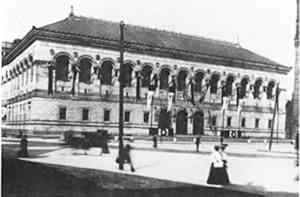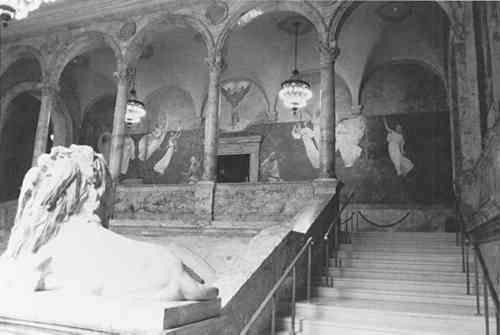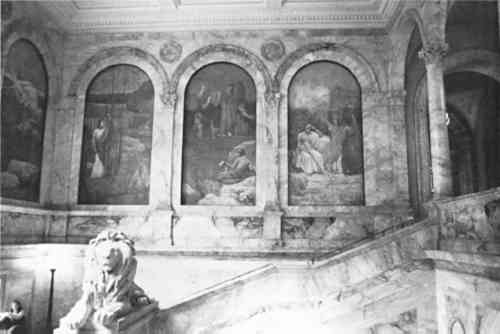PUVIS DE CHAVANNES'S ALLEGORICAL MURALS IN THE BOSTON PUBLIC LIBRARY: HISTORY, TECHNIQUE, AND CONSERVATIONTERI HENSICK, KATE OLIVIER, & GIANFRANCO POCOBENE
1 INTRODUCTIONThe Boston Public Library (fig. 1) is one of the great Renaissance Revival buildings of America. Designed and built between 1888 and 1895 by
Pierre Puvis de Chavannes (1824–98), widely considered the greatest European muralist of the time, was the ideal candidate to decorate the grandest and most complicated space in the new library. By the 1890s he had painted most of his major mural decorations, including projects for the Pantheon and the Sorbonne in Paris, and for museums and municipal buildings in Lyon, Rouen, Amiens, Poitiers, and Marseille. Although in his youth he studied for brief periods in the studios of Eugene Delacroix, Thomas Couture, and Theodore Chasseriau, Puvis's individual style and technique were developed largely independently. Combining idealized classicism with simple flat designs and pale colors, his murals were in great demand. From the beginning, the intention was that the library's imposing grand staircase and loggia be decorated with murals. Thus it was that in 1891 Charles Follen McKim traveled to Paris to engage Puvis's services. Convincing the aged painter to undertake the commission proved no easy task, but McKim was initially successful. Soon after, however, Puvis was awarded a commission for the Paris City Hall and had second thoughts about the American project. Another emissary was sent to Paris in 1892, and as a further inducement the artist was given a plaster scale model of the library's interior. Finally, on July 7, 1893, Puvis signed a contract for the murals that guaranteed him 250,000 francs, the equivalent of the then-unparalleled sum of $50,000. A year later, after completing the Paris City Hall project, the painter began working on the Boston murals and asked for more detailed measurements. He also requested, and was sent, a sample of the marble to be used in the staircase so that he might harmonize his palette with the surrounding architecture. Puvis's oversized murals were executed on canvas in a specially designed studio at Neuilly, which included a two-story door (fig. 2)(Milner 1988). The Inspiring Muses was the first mural to be painted. It was exhibited at the Salon du Champs-de-Mars, then rolled and transported to Boston in October 1895, and finally mounted on the east wall of the loggia a month later (fig. 3). During the following year, the other eight panels were completed, exhibited in Paris, shipped, and installed (fig. 4). In fact, the artist himself never saw his works in situ. Their installation using a marouflage technique was overseen by Puvis's trusted collaborator Victor Koos. The arrival of the murals in Boston was met with much fanfare and celebration. In France, on the other hand, the art critic Gustave Geffroy expressed the feelings of many Frenchmen when he wrote:
So it was that Boston acquired the only murals by Puvis to be found outside of France. |



